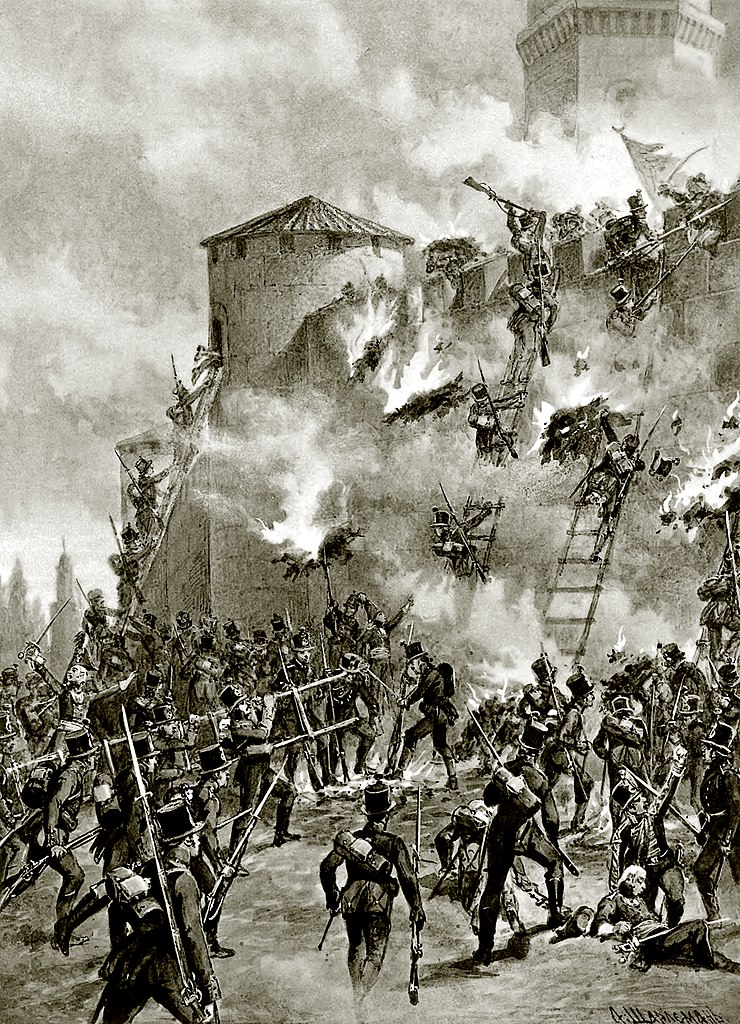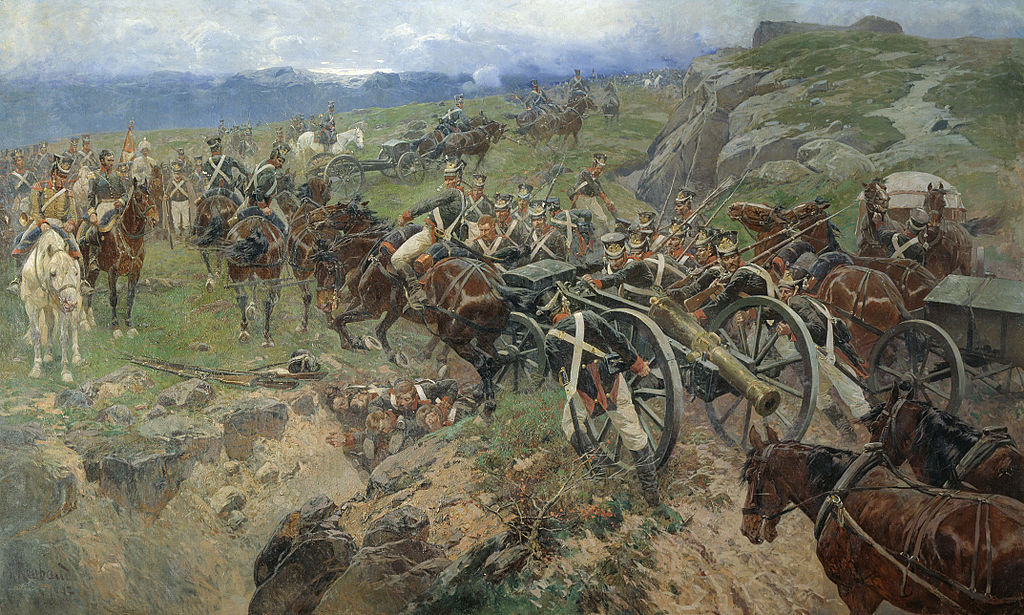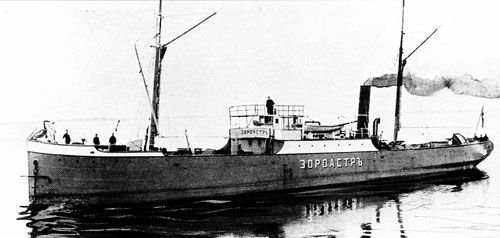| Golden Journal No. 30:
The Caspian Sea, Part Two
by Mike Bennighof, Ph.D.
May 2020
Several decades went by before the Russian court noticed the Caspian Sea again. In 1781, Empress Catherine the Great directed construction of a new flotilla. To command it she sent one of her favorites, the Bosnian Serb sailor Marko Voinovich, the commander of her imperial yacht and a highly successful frigate commander during the 1771-73 Mediterranean campaign (and later the successful commander of the Black Sea Fleet).
Voinovich had the task of first overseeing construction of three 20-gun frigates in Peter’s Astrakhan yard, along with supporting vessels, and establishing a Russian trade route across the Caspian to Persia and on to India. Voinovich sailed to Astrabad Island in the south-eastern corner of the Caspian, where he hoped to establish a trading post and flotilla base. He had no permission, with Persia having fallen into anarchy, but the local governor, Aga Mohammed Khan, invited him ashore to seal an agreement. Aga Mohammed Khan instead kidnapped Voinovich and his officers, demanding along with ransom a promise to leave the Persian coast. Voinovich paid, but set up the trading post anyway.

Persian cavalry get baked before battle.
Aga Mohammed Khan himself brought war back to the Caspian. In 1795, having made himself Shah, he invaded Georgia, then an independent if fractious kingdom. Catherine ordered a strong intervention, intending to replace Aga Mohammed Khan with his brother, then in exile in Russia. The Caspian Flotilla, now commanded by Rear Admiral Nikolai Stepanovich Fedorov supported the storming of Derbent and advance on Baku. Fedorov had a force of three frigates (it’s unclear if these were the same ships built by Voinovich) and two bomb ketches.
The Persians had no warships on the Caspian, but malaria swept through the Russian flotilla, killing Fedorov, his second-in-command and hundreds of sailors. The Russian campaign again ended with the capture of Baku and Derbent, and once again these were returned a year after the peace treaty ending the war.
Tsar Paul hatched a plan in 1800 to march a combined Franco-Russian army down the Volga to Astrakhan, across the Caspian Sea to the trading post at Astrabad, and then across Persia to invade India. Paul was assassinated before the march could take place, possibly because of this idea’s monumental stupidity.
 Conflict continued in the Caucasus, with both the Russians and the Persians attempting to exert power over the mountain khanates. Beset by Persian invaders, King Erekle (Hercules) II of Georgia asked Tsar Paul to annex his kingdom in 1800. Russian aggression continued, and in January 1804 a Russian force led by Pavel Tsitsianov stormed the fortress at Ganja (right), part of a khanate subject to Persia, and massacred the surrendered garrison and civilian inhabitants. A relief army led by the Persian Crown Prince Abbas Mirza arrived to late, but drove off the Russians in June when they advanced on the holy city of Echmiadzin in Armenia. For the next year Abbas Mirsa and the Russian commander, Pavel Tsitsianov, continued a struggle to control the small fortresses dominating the valleys of the Caucasus. Conflict continued in the Caucasus, with both the Russians and the Persians attempting to exert power over the mountain khanates. Beset by Persian invaders, King Erekle (Hercules) II of Georgia asked Tsar Paul to annex his kingdom in 1800. Russian aggression continued, and in January 1804 a Russian force led by Pavel Tsitsianov stormed the fortress at Ganja (right), part of a khanate subject to Persia, and massacred the surrendered garrison and civilian inhabitants. A relief army led by the Persian Crown Prince Abbas Mirza arrived to late, but drove off the Russians in June when they advanced on the holy city of Echmiadzin in Armenia. For the next year Abbas Mirsa and the Russian commander, Pavel Tsitsianov, continued a struggle to control the small fortresses dominating the valleys of the Caucasus.
With heavy commitments to the European war against Napoleon, the Russians could not deploy large forces in the Caucasus, but they did have control of the Caspian Sea. The Caspian Flotilla sailed south in September 1805 to attack Baku. Led by Maj. Gen. Irinarch Zavalishin, the Astrakhan port commander and one of old Marshal Suvorov’s favorites (and one of the Russian officers cashiered for calling Paul’s March on India a stupid idea), the flotilla landed 1,345 men and brought its cannon ashore to bombard the citadel. Tsitsianov ordered Zavalishin to capture several other coastal locations, and then march his troops southward over the Alburz Mountains to capture the fortress at Qazvin, which would sever communications between Azerbaijan and the rest of Persia and threaten the enemy capital at Tehran.
That insane plan never had a chance to meet its inevitable (and likely tragic) failure. The Russians bombarded Baku for eleven days, crushing the local forces that sallied to try to drive them off. The khan offered to surrender, but only played for time as the Russians ran short of food, water and ammunition. The ploy worked as Khan Shayk Ali Agha of Quba, north-west of Baku, marched to relieve Baku and forced the Russians to abandon the siege.
The flotilla returned in January, with more guns, more men and more ammunition. This time no relief force appeared and Baku eventually surrendered, despite the murder of Tsitsianov during an early abortive attempt to yield the fortress.

The Russians bridge a gulley during the Persian campaign. That’s got to hurt.
The Persians attempted to escalate the war in 1810, declaring jihad against the Russians, and when word arrived of Napoleon’s 1812 invasion of Russia the Persians redoubled their efforts, expecting the Russian troops to withdraw. The Russians kept up their deployment in the Caucasus even as Moscow fell to the invaders, and when the French retreated the Persians saw their own chances of victory fade with them.
The Treaty of Gulistan, brokered by the British and finally signed in October 1813, humiliated Persia. Most Persian holdings in the Caucasus were ceded to Russia, and the Persians agreed to give the Russians the sole right to maintain both warships on the Caspian Sea. The treaty did not specifically give the Russians the rights to their trading post at Astrabad, but it did guarantee free trade for the Russians throughout Persian lands and they kept the outpost.
With British aid, Abbas Mirza built a modern Persian army using European weapons, drill and tactics. The Persians used their new army to inflict a grievous defeat on the Ottomans at Erzurum in 1821, and after Persia made peace in 1823 the British pressed Abbas Mirza and his father, Shah Fath Ali, to turn their new instrument of war on the Russians. That proved a disaster for Persia, as the Russians conquered the rest of the Persian Caucasus and forced Fath Ali to re-affirm the clauses of the 1813 treaty yielding rights to maintain warships on the Caspian to the Russians.
Despite the lack of opposition, the Russians kept the flotilla on the Caspian over the decades that followed, deploying it on a series of intensive surveying operations to develop detailed maps of the entire basin. Most of the ships now used Astrabad as their home port, though new warships were built at Astrakhan to replace the aging vessels constructed by Voinovich and Zavalishin.
The Caspian finally fulfilled its promise of treasure later in the century. In 1847 the first mechanical oil well was drilled at Baku, and more followed as the region became the world’s leading oil producer. In 1859 the first kerosene plant opened, followed by new works producing paraffin and candles. Baku developed rapidly into a European-style industrial city, with other factories producing textiles, tobacco products and oil-drilling machinery following.

The tanker Zoroaster.
The oil flowed northward to Russia by water: the first world’s first steam-powered oil tanker, Zoroaster, reached the Caspian in 1880. Built in Sweden, the 400-ton ship had a steel hull and carried oil from Baku to Astrakhan and Tsaritsyn on the Volga. She continued in service for almost seven decades, finally begin scuttled as a breakwater in 1948.
The Caspian Flotilla moved its headquarters from Astrakhan to Baku in 1867, but the inland armada did not modernize to match the new steam-powered merchant fleet - 354 bulk freighters plied the Caspian by the turn of the century, 133 of them steam-powered. Finally, in 1910 the Russians built two modern gunboats for the Caspian Sea.
Click here to join the Gold Club.
See your Gold Club Insider newsletter for ordering information.
Sign up for our newsletter right here. Your info will never be sold or transferred; we'll just use it to update you on new games and new offers.
Mike Bennighof is president of Avalanche Press and holds a doctorate in history from Emory University. A Fulbright Scholar and NASA Journalist in Space finalist, he has published over 100 books, games and articles on historical subjects.
He lives in Birmingham, Alabama with his wife, three children and his dog, Leopold.
|
